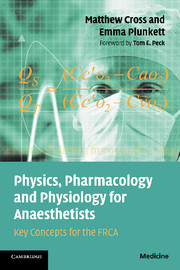Book contents
- Frontmatter
- Contents
- Acknowledgements
- Preface
- Foreword
- Introduction
- Section 1 Mathematical principles
- Section 2 Physical principles
- Section 3 Pharmacological principles
- The Meyer–Overton hypothesis
- The concentration and second gas effects
- Isomerism
- Enzyme kinetics
- Drug interactions
- Adverse drug reactions
- Section 4 Pharmacodynamics
- Section 5 Pharmacokinetics
- Section 6 Respiratory physiology
- Section 7 Cardiovascular physiology
- Section 8 Renal physiology
- Section 9 Neurophysiology
- Section 10 Statistical principles
- Appendix
- Index
Adverse drug reactions
Published online by Cambridge University Press: 15 January 2010
- Frontmatter
- Contents
- Acknowledgements
- Preface
- Foreword
- Introduction
- Section 1 Mathematical principles
- Section 2 Physical principles
- Section 3 Pharmacological principles
- The Meyer–Overton hypothesis
- The concentration and second gas effects
- Isomerism
- Enzyme kinetics
- Drug interactions
- Adverse drug reactions
- Section 4 Pharmacodynamics
- Section 5 Pharmacokinetics
- Section 6 Respiratory physiology
- Section 7 Cardiovascular physiology
- Section 8 Renal physiology
- Section 9 Neurophysiology
- Section 10 Statistical principles
- Appendix
- Index
Summary
Although not often tested in depth, a knowledge of the terminology used to describe adverse drug reactions is useful. True anaphylactic and anaphylactoid reactions clearly require a more detailed knowledge. The official World Health Organization (WHO) definition of an adverse drug reaction is lengthy and unlikely to be tested. A more succinct definition is used in relation to anaesthesia.
Adverse drug reaction
The occurrence of any drug effect that is not of therapeutic, diagnostic or prophylactic benefit to the patient.
Types of adverse reactions
The WHO definition encompasses six groups, which need not be memorized but which are included for completeness.
Group 1 Dose-related reactions
Group 2 Non-dose-related reactions
Group 3 Dose- and time-related reactions
Group 4 Time-related reactions
Group 5 Withdrawal reactions
Group 6 Treatment failure.
The reactions can be more simply defined as one of two types:
Type A
dose dependent
common
extension of known pharmacological effect.
Type B
dose independent
uncommon
symptoms and signs of drug allergy.
The most important type to the anaesthetist is type B, which encompasses both anaphylactic and anaphylactoid reactions.
Anaphylactic reaction
A response to a substance to which an individual has been previously sensitized via the formation of a specific IgE antibody. It is characterized by the release of vasoactive substances and the presence of systemic symptoms.
Anaphylactoid reactions
A response to a substance that is not mediated by a specific IgE antibody but is characterized by the same release of vasoactive substances and presence of systemic symptoms as an anaphylactic reaction.
- Type
- Chapter
- Information
- Physics, Pharmacology and Physiology for AnaesthetistsKey Concepts for the FRCA, pp. 89 - 90Publisher: Cambridge University PressPrint publication year: 2008



